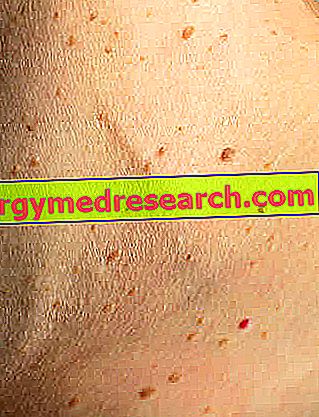Generality
Flat warts are fairly common benign lesions of the skin .
These formations are due to the infection sustained by the human papilloma virus (HPV). The infection occurs by contact with infected people and is favored by hot and humid environments (such as swimming pools), which make the skin less resistant to external attacks.

See Photos of Flat Warts
Flat warts appear as smooth lenticular or papular lesions of a few millimeters in diameter, yellow-brown in color, often numerous and placed side by side. In fact, these alterations tend to develop through self-inoculation. Flat warts are located mainly on the face and back or on the fingers.
Sometimes the HPV infection responsible for the lesions may be transient, so it heals spontaneously without leaving any results. In any case, it is good not to underestimate them: to prevent them from spreading to other skin sites and thus becoming even more difficult to eradicate, it is good to eliminate them with topical drugs, surgical removal, diathermocoagulation or cryotherapy.
Causes and risk factors
Flat warts are caused by an infection of the human papilloma virus ( HPV ). In particular, these formations are caused by the viral strains 3, 10, 28 and 49, which induce the proliferation of epidermal cells, giving rise to skin lesions with a lenticular or papular appearance.
The infection occurs:
- For direct contact with people who are already affected (for example, by touching someone else's warts);
- For exposure to contaminated surfaces in busy areas, such as showers and saunas in gyms, common changing rooms and pool edges.
The infection is favored by hot and humid environments, which favor the survival of the virus in an active form and make the skin less resistant to external attacks. Furthermore, transmission can take place via self-inoculation .
Once the infection has occurred, after an incubation period of one to eight months, the typical lesions appear on the skin of the host.
The spread of flat warts seems to be favored by general disorders of the organism and by local and systemic immunological factors : immunosuppressed patients (from AIDS, organ transplantation or various autoimmune diseases) are particularly at risk for the development of such injury. Other factors that seem to influence the onset include hormonal imbalances and psychological problems (stress, anxiety, etc.).
Flat warts are more common among children and young adults.
The development of warts is closely related to the immune status and not all individuals have the same risk of becoming infected .
Normally, humoral immunity has the task of protecting against the attack of the viral agent (HPV); cell immunity, on the other hand, helps to reverse the contracted infection.
When the human papilloma virus penetrates the skin of immunologically debilitated people, skin infection develops. On the other hand, subjects who are not compromised from an immune point of view are less vulnerable and tend to reject the viral attack.
The "quality" of the skin and its defensive barriers also influence the vulnerability to contract the infection. In particular, abrasions, traumatisms and skin maceration facilitate initial epidermal inoculation. Therefore, the attendance at bare feet of environments, such as swimming pools and dressing rooms of gyms, where humidity favors the maceration of the skin makes it easier to take root of the warts.
Note. Warts can appear on any part of the body, with various morphologies. Among the various forms we can distinguish common (or vulgar), filiform, mosaic, acuminate and genital (or condyloma) warts.
Symptoms
Flat warts are lenticular or papular lesions, yellow-brown in color. Most of the time, these skin formations are located on the face, on the back of the hands and along the scratching lesions (a linear arrangement is not uncommon), but may also be present in other skin sites.
These formations are characterized by a flat or slightly raised surface, well demarcated, from 2 to 5 mm in diameter (the dimensions are comparable to those of a pinhead). Flat warts can be isolated or combined in small groups.
In some cases, it can happen that, just as they appear suddenly, they disappear by themselves. Generally, flat warts are asymptomatic, but are often numerous and resistant to treatment.
Diagnosis
The diagnosis of flat warts is formulated on the basis of the clinical aspect ; rarely, biopsy is required.
A fundamental sign of warts is the absence of transverse cutaneous lines on their surface and the presence of black spots at the apical end (thrombosed capillaries) or hemorrhage when these lesions are cut. In some medical centers, DNA typing is available, but it is generally not necessary for flat warts.
The differential diagnosis is made against vulgar warts, squamous cell carcinoma in situ and verruciform epidermodysplasia.
Prognosis
Some flat warts regress spontaneously, without therapy; others persist for years and reappear in the same locations or at different sites, even after treatment.
It appears that factors capable of influencing recurrences are related to the patient's overall immunological status and local conditions.
Treatment
The treatment aims to activate an immune response against HPV; in most cases, this goal is achieved through the application of keratinolytics or irritants, such as preparations based on salicylic acid, 5-fluorouracil and tretinoin. These compounds can be used in combination with each other or be associated with an ablative method (eg cryosurgery with liquid nitrogen, diathermocoagulation, curettage and laser excision) to increase the probability of success.
The choice of the method used varies according to the location and the gravity of the interest. In general, for flat warts, the daily application of tretinoin (0.05% retinoic acid cream) is indicated. If exfoliation is not sufficient for the removal of the flat wart, it is possible to apply another agent (such as 5% benzoyl peroxide) or 5% salicylic acid in cream, sequentially to tretinoin. This type of treatment can be performed at home, provided you follow the dermatologist's instructions carefully.
Cryotherapy is based on the freezing activity of liquid nitrogen; this approach can be painful, but it is extremely effective.
The diathermocoagulation instead exploits the properties of the high frequency current to burn flat warts, while laser surgery involves the use of specific rays with ablative function.
Furthermore, in association with topical drugs or demolition methods, it is possible to use 5% amiquimod in cream (stimulates the local synthesis of antiviral cytokines by skin cells) or topical 5-fluorouracil (cream at the top). 1% or 5%).
Finally, in rare cases, systemic therapy with immunomodulatory drugs may be indicated. This approach is generally reserved for the most stubborn cases and when there are many flat warts.
Prevention
To avoid contracting flat warts, you can follow simple recommendations:
- Avoid direct contact with other people's warts or with one's own (self-inoculation is frequent).
- Treating the state of hygiene of the skin: the presence of lesions facilitates the entry of viruses, while a healthy and wound-free skin surface is more resistant to viral attack.
- Once the infection is contracted, it is necessary to avoid scratching and manipulating the warts in order not to spread the virus to other skin areas.
- Avoid walking barefoot, especially in public places (on the edges of swimming pools, in the changing rooms of swimming pools and gyms, in common showers, etc.).
- Do not share the use of scissors and files, towels, linens and shoes.
- Do not wear heavy footwear that does not allow perspiration, as abrasion and maceration caused by sweat are factors favoring papilloma virus skin attacks.



